Application of RS & GIS in Disaster Management
Application of RS & GIS in Disaster Management. L.P.Sharma , lp.sharma@nic.in National Informatics Centre Sikkim State unit Department of Information Technology Government of India.
Share Presentation
Embed Code
Link
Download Presentation
- slope angle
- geospatial data requirement
- survey work activity map
- statistical analyses
- administrative offices
- id panchromatic image

lev + Follow
Download Presentation
Application of RS & GIS in Disaster Management
An Image/Link below is provided (as is) to download presentation Download Policy: Content on the Website is provided to you AS IS for your information and personal use and may not be sold / licensed / shared on other websites without getting consent from its author. Content is provided to you AS IS for your information and personal use only. Download presentation by click this link. While downloading, if for some reason you are not able to download a presentation, the publisher may have deleted the file from their server. During download, if you can't get a presentation, the file might be deleted by the publisher.
Presentation Transcript
- Application of RS & GIS in Disaster Management L.P.Sharma, lp.sharma@nic.in National Informatics Centre Sikkim State unit Department of Information Technology Government of India
- Disaster Management has been a work of great challenge for the governments at local, national and international levels. • Be it Tsunami, cyclone or landslide they create tremor not only on ground but also in the hearts and minds of people . • Knowing the challenge and the urgency to nab it, disaster management has become a job prerogative of the United Nations Development Program (UNDP).
- Geo-informatics has been successfully used in preparing, planning, analyzing, forecasting, mitigation and risk assessment of various types of disasters. • Geo-informatics tools can be actively used in handling both pre-disaster and post disaster situations. • From snow removal and avalanche management in Canada and United States to flood , tsunami and landslide hazard management in many Asian countries, Geo-informatics tools are being actively and success fully used all across the world.
- Major Disasters • Landslide • Tsunami • Flooding • Drought • Avalanche • Fire • Road Accident • Train Accident • Flight Crash
- Landslide Study & Management • Input Data Requirement • Geological Map • Structural Map • Geomorphologic Map • Pedological Map • Petrology or Litho logy Map • Topographic Map • Administrative Boundary Map • Transportation Network Map • Drainage and Water bodies map • Land Use/Land Cover Maps • Contour Maps • Major Thrust Area Map • Slope Angle Map • Aspect map
- Satellite Imagery • IRS-IC Multi-spectral LISS –III/AWiFS image of few years taken during end-monsoon seasons. • IRS-ID Panchromatic Image • Arial Photos • Statistical DATA • Annual Precipitation data of the study area • Demographic Data • Seismological Data
- Factors Causing landslide • Expected Factors Causing Landslides • Constant/Conditioning Factors • Rock types----Petrology Map • Rock Structure----Geological Map/ Structural Map • Slope Angle------- Slope Map/DEM • Soil Type---- Soil Map from Survey of India • Near By Thrust Area---Satellite Image/Ariel Picture • Surface Techtonism-----Seismic Ranking
- Expected Factors Causing Landslides • …. • Triggering Factors • Rainfall----------Weather Bureau/Rain Gauge • Seismic Occurrence---Earth Quake History • Anthropogenic Interference • Road Construction----Survey Work/Activity Map • Rail Link Construction—Survey Work/Activity Map • Deforestation----Survey work/Activity Map.
- Major Steps for landslide Probability Study • GPS Survey of the Study Area/Digitization of Contour Maps from Topographic map • Generation of DEM out of the GPS Data/Contours • Identification of triggering factors (variables) • Dividing the study area based on ward/village boundaries or control points and geological coherence into many divisions • Categorization of variables and constants for every small portion of the study area. • Identification of variable values for each such portion of the study area
- Proposing a formula for landslide probability based on the various triggering factors. • Calculation of landslide probability of the selected area using various methods like statistical, deterministic, fuzzy logic, Bayesian network or artificial neural network. • Checking it with the real landslide history of the past. • Repeating the process unless the calculation matches with the landside history data. • Publishing a table of identified locations that are prone for landslide with a range of precipitation.
- Case Study • Probabilistic Techniques, GIS and Remote Sensing in Landslide hazard Mitigation:A case study from Sikkim Himalayas, India • D.Ramakrishnan, M.K.Ghosh, R.Vinu Chandra and A. Jeyaram. • Study Area • The investigated area (Figure 1) forms a part of East Sikkim district and lies between the northern latitudes 27 ˚15΄-27˚30΄ and eastern longitudes 88˚30΄-88˚45΄.
- Characteristics of the Study Area • Geomorphology: Tectonic, glacial, fluvial processes • Elevation: 600 m to 4500 m • Average Rainfall: 3539mm • Geology :Precambrian rocks Phyllite, Chlorite Schist, quartz, pockets of sandstone, shale and conglomerate Major Thrust: Main Boundary Thrust Main Central Thrust Yumthang Thrust
- Followed Methodology • Identification of conditioning and triggering factors (variables) • Data processing for GIS environment, modeling, and validation of results with satellite / field data • Data on lithology, seismicity, structure are collect from the field, satellite data and existing sources. • The slope map is generated using GPS data from the field in conjunction with the information from Survey of India topographic sheets • A satellite data set (IRS-LISS-3) for the period December 1998 is used to map landslide events of the past • A similar land slide event map for the period January 2002 is used for comparing and validating the probable hazard zones generated using information theory and regression analysis. • Raster data are rectified and registered using ERDAS-IMAGINE version 8.5. The vector layer is generated in ARC/INFO version 7.1. The programmed for statistical analysis is written in Visual Basic with Arc Macro Language (AML) as back end.
- Methodology Flowchart
- Identification of Conditioning Factors • The study area is divided into 172 small blocks/ elements based on slope, aspect and watershed divide .From the field investigations, identifies following variables (M) as key conditioning and triggering factors. • (A) Lithology: • .if Mica Schist then X1=1 else 0 • .if Phyllite then X2=1 else 0 • .if Granite then X3=1 else 0 • .if Gneisses then X4=1 else 0 • (B) Seismicity/ earthquakes: if earthquakes (with Mb>2) epicenter is 2) epicenter is 2) epicenter is
- (C ) Slope Angle: • .if slope > 46 then X8= 1 else 0 • .if slope 35 - 45˚ then X9= 1 else 0 • .if slope 25 - 34˚ then X10= 1 else 0 • .if slope 15 - 24˚ then X11= 1 else 0 • .if slope
- All the different input layers are interacted in ARC/INFO and the statistical analyses are done on the resultant layer in Visual Basic front end. • Result from this analysis will be in tabular form. The output will comprise details pertaining to the information value and regression coefficient of variables • Information value and regression value of each element, minimum and maximum information value and regression value, element number and grades of instability associated with each element. • This data can be further classified into different grades of instability based on the range of information and regression value and the number of elements in each of the instability classes.
- Result • The zonation done on the basis of the information value method, regression value method overlaid on the actual landslide map testifies the suitability and authenticity of the methodology.
- Result • In order to increase the accuracy of prediction, results from information value and regression analyses are combined into the following new classes. • IVHighand RVHigh => Very High • IVHigh and RVMedium OR IVMedium and RVHigh => High • IVHigh and RVLow OR IVLow and RVHigh OR IVMedium and • RVMedium =>Medium • IVMedium and RVLow OR IVLow and RVMedium =>Low • IVLow and RVLow =>Very Low
- Geo-Informatics for Fire Hazard • Geospatial Data required • for rural areas: • smallest administrative boundaries transportation network layers, settlement layers, forest layers, land cover layers and population centers, point of water tanks location • For urban Areas: spacio-temporal traffic information, fire brigade locations in addition to the above. • Satellite Images or the aerial photographs of the area.
- These data should be ready at the GIS enabled fire brigade control room. • The occurrence of the fire accident is reported to the control room by traffic police or any citizen using any mode of communication giving the exact location like place name, street no., house no. etc. • Based on the received information, a point event of occurrence of accident is created in GIS • Distance of the point from all the near by fire brigade offices with fire vans and the source of abundant water will be calculated with in a second and listed by the GIS. • Based on the time of the accident the shortest and suitable route to the point will be suggested by the GIS. • In a networked GIS the software can be customized to send automatic alert of the information to all concerned authorities.
- Geo-informatics for Tsunami • Geospatial Data Requirement: • Administrative boundaries up to the sea shore. • All important point locations with in the boundaries. • Point Locations of disaster management control rooms, police stations, administrative offices etc. with sufficient information about each of them in the attribute table. • The occurrence of tsunami is informed to the Disaster Management Control Room either by an automated machine placed at the sea shore, any citizen or government servant.
- On the basis of the received information about the place of occurrence the control room GIS operator will prepare an estimated effected area map immediately. • At the same time an alert will be sent to all disaster management authorities within and in the near by area who will then rush to the effected area with the GPS and devices for communication. • The team will then keep on informing all the details to the GIS enabled control room where based on the received information following details will be prepared and communicated to all the concerned authorities.
- villages that are effected by the tsunami • the number of houses, public properties and the population that are effected by the tsunami. • The amount of loss vis-à-vis the estimate of rehabilitation teams, medicines, food grains to be arranged • subsequently the budget requirement can be almost accurately made sitting at the desktop.
- Similarly GIS can also be used for • Monitoring of the rehabilitation progress • Providing inputs for further action. • Preparing reports on the ongoing work with respect to percentage of coverage and completion. • Monitoring of the epidemic due to tsunami
- Geo-Informatics for Epidemics Management • Geospatial Data Requirement: • Drainage layer showing open outlets • Ponds and other water bodies • Administrative boundaries with slum areas. • Water Tanks and Water Distribution Networks with enough attribute information on purification process etc. • Movement of infectious animal carrier • Settlement Area • Forest Area.
- Identify the prime factors that may cause outbreak of any types of disease from the above mentioned layers. • Overlay all the geospatial layers for over lay analysis. • The resultant polygons will be so many in numbers and each of these polygons will have attribute information from all the input layers. • Any of the statistical method or more then method can be used to study the probability of out break of any kind of epidemics in each of the polygons. • A suitable algorithm can be designed to calculate the probability information for all the polygons in one go.
- Based on the probability Information Value the who of the study area be segregated in high, medium and low probability zones. • The polygons with more then 50 % probability of occurrence can be segregated for taking special precautionary action. • If at all an epidemic out breaks in the given area, the point location of out break is immediately entered in the GIS . • Then a buffering is created around the point to make as assessment of the nearby areas which are vulnerable to epidemic. • The Geo-Informatics tools will be helpful in monitoring both the pre and post epidemic scenario very effectively.
- Geo-Informatics for Flood Management • In the similar way as in other disasters the various geospatial data can be used as input layers to analyze the following: • Flood inundation mapping and monitoring • Rapid and scientific based damage assessment • Monitoring and mapping of flood control works and changes in river course • Identification of river bank erosion • Identification of chronic flood areas • Inputs for flood forecasting and warning models
- Geo-Informatics for Cyclone • Similarly the geo-informatics tools and the geospatial data can be effectively used in cyclone management specially for : • Collation and compilation of spatio-temporal weather information for weather monitoring • Cyclone mapping and risk assessment. • Cyclone forecasting and preparation of warning models
- Geo-informatics can be applied in other disasters as well in the following way: • Drought • Monitoring of crop growth, moisture content • Identification of water bodies including amount of water • Demarcation of ground water prospect zones communication
- Volcanic Eruption • Monitoring the thermal characteristics of the earth surface and crust for depicting shape and extent of lava flow. • Estimation of the area likely to be affected from the event. • Estimation of damage in case of occurrence of the event. • Earth Quake • Mapping of active faults • Measurement of fault displacement • Post-earthquake damage assessment
- Geo-Informatics in accidents handling • Road Accidents & Train Accident : • Mapping of the accident spot in GIS • Calculation of distance to the nearest settlement area, NGO offices, police stations, schools and hostels from where first rescue teams can be requested for. • Calculation of distance to the nearest hospitals and working out the shortest and traffic free route to the hospitals. • Detail mapping of the accident area in case of loss of bodies, belongings and valuables.
- Thank YOU
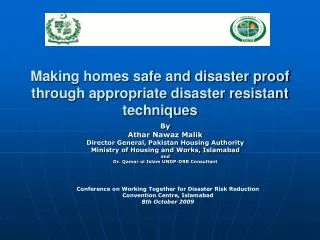
Making homes safe and disaster proof through appropriate disaster resistant techniques
Making homes safe and disaster proof through appropriate disaster resistant techniques By Athar Nawaz Malik Director General, Pakistan Housing Authority Ministry of Housing and Works, Islamabad and Dr. Qamar ul Islam UNDP-DRR Consultant Conference on Working Together for Disaster Risk Reduction
1.43k views • 35 slides
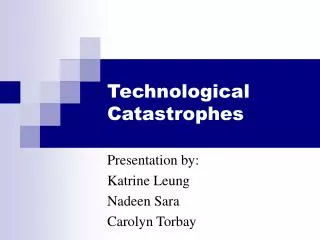
Technological Catastrophes
Technological Catastrophes Presentation by: Katrine Leung Nadeen Sara Carolyn Torbay Technological catastrophes What is the difference between a technological disaster and a natural disaster? Has anyone lived through a technological disaster? Anyone you know?
1.13k views • 48 slides
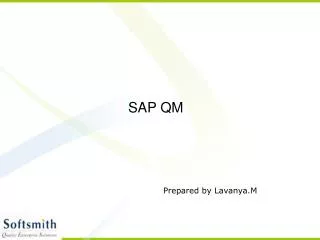
SAP QM
SAP QM Prepared by Lavanya.M Quality Management Quality Management Module deals with all traditional functions of quality in an organization. The integration of the QM application component in the SAP system allows quality management tasks to be combined with those in other
4.01k views • 34 slides

Hospital Disaster Preparedness
Hospital Disaster Preparedness. Special Committee on Disaster Preparedness Planning December 13, 2006. What We Are Preparing For: All Hazards. B ioterrorism, O ther I nfectious D isease O utbreaks, and O ther P ublic H ealth T hreats and E mergencies. Goals of Preparedness.
4.96k views • 35 slides

SAP QM
SAP QM. Prepared by Lavanya.M. Quality Management. Quality Management Module deals with all traditional functions of quality in an organization. The integration of the QM application component in the SAP system allows quality management tasks to be combined with those in other
3.08k views • 34 slides

FLIXBOROUGH DISASTER
FLIXBOROUGH DISASTER. The Flixborough disaster was an explosion at a chemical plant close to the village of Flixborough England on 1 st June 1974. It killed 28 people and seriously injured 26. The chemical plant, owned by Nypro (UK) and in operation since 1967.
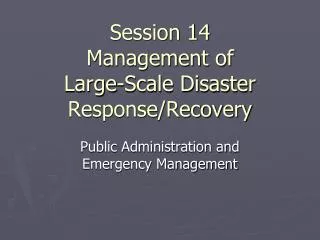
Session 14 Management of Large-Scale Disaster Response/Recovery
Session 14 Management of Large-Scale Disaster Response/Recovery. Public Administration and Emergency Management. Objectives. At the conclusion of this session, students will be able to Discuss the response and recovery processes for large-scale disasters
1.37k views • 105 slides
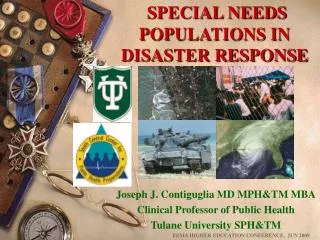
SPECIAL NEEDS POPULATIONS IN DISASTER RESPONSE
SPECIAL NEEDS POPULATIONS IN DISASTER RESPONSE. Joseph J. Contiguglia MD MPH&TM MBA Clinical Professor of Public Health Tulane University SPH&TM. FEMA HIGHER EDUCATION CONFERENCE, JUN 2009. DISASTER. OVERVIEW. Introduction to special needs Culture & Religion Challenges Tools
1.1k views • 86 slides

Emergency/Disaster Preparedness
Lisa Randall, RN, MSN, ACNS-BC RNSG 2432. Emergency/Disaster Preparedness. Objectives. Compare and contrast interdisciplinary roles and responsibilities associated with emergency and disaster situations. Compare and contrast risk factors associated with need for emergency care.
1.14k views • 84 slides
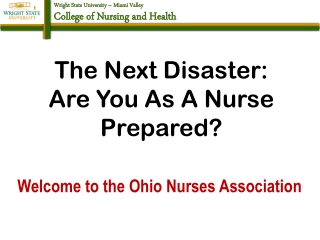
The Next Disaster: Are You As A Nurse Prepared?
The Next Disaster: Are You As A Nurse Prepared?. Welcome to the Ohio Nurses Association. Why are we concerned about disasters?. According to FEMA, Major Disaster Declarations have steadily increased since 1953 #13 in 1953 #81 in 2010 #99 in 2011 #47 in 2012
1.23k views • 100 slides

Web Application Proxy vs. TMG
Ing. Ondřej Ševeček | GOPAS a.s. | MCM: Directory Services | MVP: Enterprise Security | Certified Ethical Hacker | ondrej@sevecek.com | www.sevecek.com |. Web Application Proxy vs. TMG. Web Application Proxy. Threat Management Gateway vs. WAP. Threat Management Gateway.
1.11k views • 31 slides
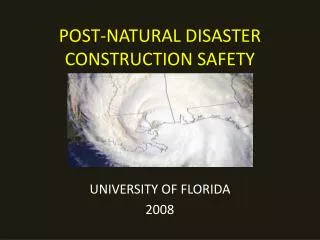
POST-NATURAL DISASTER CONSTRUCTION SAFETY
POST-NATURAL DISASTER CONSTRUCTION SAFETY. UNIVERSITY OF FLORIDA 2008. English/Spanish Low-Literacy Worker Safety Training for “Focus Four” Disaster Reconstruction Hazards. This course development training have been sponsored by a Susan Harwood Training Grant. HURRICANE. TORNADO.
1.44k views • 124 slides
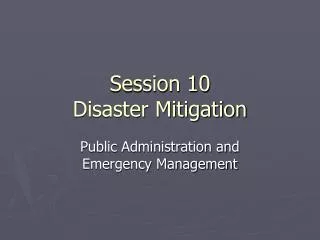
Session 10 Disaster Mitigation
Session 10 Disaster Mitigation. Public Administration and Emergency Management. Objectives. At the end of this session, students should be able to Discuss the government role in helping individuals recover from disaster Discuss the process of damage assessment and its implementation
1.06k views • 88 slides

Disaster Ready…or Not? Stan Szpytek, AzHCA Consultant Life Safety / Disaster Planning
Disaster Ready…or Not? Stan Szpytek, AzHCA Consultant Life Safety / Disaster Planning. Arizona Health Care Association. AZ’s largest LTC Association AHCA’s members facilities- 15,000 residents AZ’s Long-Term Population Stats 150 licensed SNF / 16,346 beds 1880 licensed ALF / 30,095 beds
995 views • 86 slides
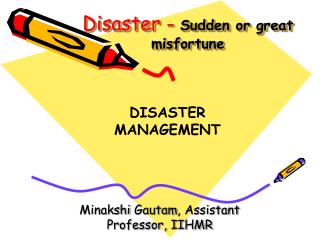
Disaster - Sudden or great misfortune
Disaster - Sudden or great misfortune. DISASTER MANAGEMENT. Minakshi Gautam , Assistant Professor, IIHMR. Introduction. ‘Disaster Originated from a french word Combination of two terms Des and astre ‘Des’ meaning bad or evil and ‘astre’ meaning star
1.85k views • 156 slides
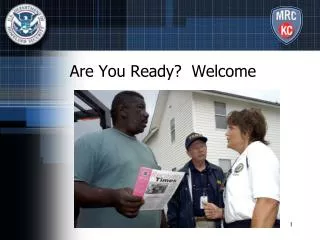
Are You Ready? Welcome
Are You Ready? Welcome. Agenda. Introduction Identifying hazards Taking protective measures for specific hazards Creating a family disaster plan Assembling a disaster supplies kit Recovering from disaster Conclusion. Objectives.
2.42k views • 229 slides
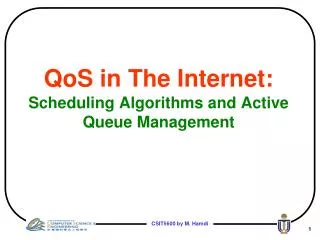
QoS in The Internet: Scheduling Algorithms and Active Queue Management
QoS in The Internet: Scheduling Algorithms and Active Queue Management. Principles for QOS Guarantees. Consider a phone application at 1Mbps and an FTP application sharing a 1.5 Mbps link. bursts of FTP can congest the router and cause audio packets to be dropped.
1.55k views • 123 slides

Disaster-Tolerant OpenVMS Clusters Keith Parris
Disaster-Tolerant OpenVMS Clusters Keith Parris System/Software Engineer HP Services – Systems Engineering Hands-On Workshop Session 1684 Wednesday, October 9, 2002 8:00 a.m. – 12:00 noon. Key Concepts. Disaster Recovery vs. Disaster Tolerance
1.05k views • 80 slides

Disaster Debris Management
Debris Management. California Emergency Management Agency. Disaster Debris Management. It’s Not Just Taking Out The Trash. Debris removal costs average 40% of the total cost of a disaster Debris quantities in natural events are increasing Natural disasters are happening more often
1.7k views • 111 slides

Business Continuity and Disaster Recovery Planning
Business Continuity and Disaster Recovery Planning. CISSP Guide to Security Essentials Chapter 4. Objectives. Running a business continuity and disaster recovery planning project Developing business continuity and disaster recovery plans
1.87k views • 79 slides
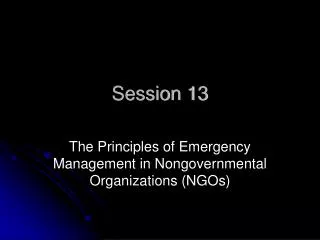
Session 13
Session 13. The Principles of Emergency Management in Nongovernmental Organizations (NGOs). Objectives: Students Will. Understand the NGO role in the national emergency management system Understand how NGO emergency managers coordinate and collaborate in disaster activities
1.05k views • 86 slides























